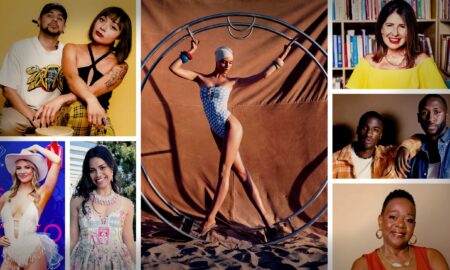

Today we’d like to introduce you to Jackson Hunt.
Hi Jackson, it’s an honor to have you on the platform. Thanks for taking the time to share your story with us – to start maybe you can share some of your backstory with our readers?
I grew up in Portland, Oregon where my mom’s side of the family has been for multiple generations. My mom’s side of the family is Klamath/Modoc and Cherokee and they moved up from Chiloquin during WWII to work in shipyards. My family is very creative — my mom is a dancer and potter, my dad is in theater, my brother is an experimental filmmaker, and my grandmother drew and painted and made star quilts and pots — so being an artist was nurtured in me from a young age. I always loved drawing, and when I was 13, I took a class called “Painting After the Masters” taught by an artist named Sean Cain, which was my first exposure to oil painting. The first oil painting I ever made was a cropped copy of Titian’s portrait of Ranuccio Farnese and after that, I was hooked. It gave me the framework to keep going and eventually make original work using the same indirect painting techniques. When I teach undergraduate painting, I like to include one master copy assignment because so often, the students are blown away by what they can do when they know the steps and how to make it happen. That experience really guided the next chunk of my life and led me to move to Brooklyn for a BFA at Pratt Institute. I moved to California to pursue an MFA at UC Irvine in 2017 and since finishing, I’ve been living and working in Los Angeles.
Alright, so let’s dig a little deeper into the story – has it been an easy path overall and if not, what were the challenges you’ve had to overcome?
It’s definitely been a process. Pursuing art, or balancing a life so that you can make art, is a huge challenge. I’ve worked so many different jobs in order to have a flexible schedule that allows for studio time. I’ve done retail, restaurant work, art handling, taught kids from elementary school through college, painted murals, done scenic painting for theater and television, and worked as an artist’s assistant. And on top of that, there are all of the challenges in the studio. My work has changed a lot over the past few years. After a decade or more of traditional oil painting, I began exploring different processes and mediums.
Even while painting more traditional oil paintings, I always wanted to think of different ways that I could work within the parameters of figuration and realism, be it through shifting the color palette or adding a drawn or abstracted element to the work that I didn’t anticipate at the beginning of the process. Much of the work was rooted in a photographic reference so adding a variable that’s unknown made the paintings feel exciting and kept it challenging. As my work has become more abstract and deals with the photo in a physical sense, that element of chance and discovery has moved to the forefront. It’s exciting but can feel stressful when you don’t know what’s next or if it will be any good! I like that process of learning how to make a painting that you can’t imagine ahead of time.
Alright, so let’s switch gears a bit and talk business. What should we know about your work?
My current body of work is a material-based exploration in abstraction that examines my personal family history, lived experience and relationship to a photographic archive. My paintings are mixed media, acrylic paint and collage on canvas-wrapped panels. I use the same images over and over in the paintings, working in an additive and subtractive process. I use a limited palette of CMYK applied in thin washes and sprays of acrylic paint in order to achieve more complex hues. The paintings themselves reference a digital language, photography, and tromp l’oeil techniques.
I’m interested in the ways that abstraction occurs through repetition, distortion or degradation and how a familiar image can transform and become illegible when divorced from its context. This is interesting to me in connection with my own family’s personal archive of images. Looking through boxes of photographs can transport you into different moments and memories but can also create new memories based on the connections we make on our own. I’m interested in the malleability of memory and narrative as a real experience and I want my paintings to touch on that.
As a Native family, we are lucky to be able to have access to images of our family dating back to the late nineteenth century to the present day and through those images, we can see relationships and life events and relocating from one place to another. We have pictures of weddings, and vacations, the Native pre-k my grandmother ran called E-Kosh Kosh, powwows, birthday parties, and my naming ceremony. But that information is embedded and dependent on elders to communicate those stories. I like painting’s potential to capture and contain stories outside of legibility and abstraction as a tool to talk about the personal.
What quality or characteristic do you feel is most important to your success?
I think it’s just persistence. I love painting even when I hate it. I’m excited to keep playing and exploring and pushing the limits of what I think I can do. There are many more things that I still want to make and images I don’t yet know that I want to make. Art is so expansive and I love the parameters of painting to help me think through ideas with some guidance even though the possibilities still feel limitless.
Contact Info:
- Website: jacksonhunt.com
- Instagram: jacksonhunt___







 Image Credits
Image Credits
Photos by Tyler Haberkorn, Ewa Slapa, and Paul Salveson.














